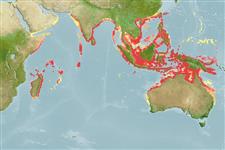Environment: milieu / climate zone / depth range / distribution range
นิเวศวิทยา
เกี่ยวกับทะเล,น้ำเค็ม; น้ำจืด; กร่อย ผิวน้ำ; ปลาที่อพยพจากแหล่งน้ำเค็มไปวางไข่ในแหล่งน้ำจืด (Ref. 51243); ระดับความลึก 6 - 55 m (Ref. 12260). Tropical; 25°N - 30°S, 43°E - 155°E (Ref. 54703)
Indo-West Pacific: Indian Ocean: east coast of Africa northward from about Durban (Ref. 3509) to the Gulf of Oman (Ref. 188), including Madagascar (Ref. 188, 3509), the coasts of India and Andaman Sea (Ref. 188, 6867), and south to western Australia (Ref. 188); also South China Sea (Ref. 188), and Indonesia to northern Australia and Papua New Guinea (Ref. 188, 6867).
Length at first maturity / ขนาด / น้ำหนัก / Age
Maturity: Lm 13.5 range ? - ? cm
Max length : 16.0 cm SL เพศผู้/กระเทย; (Ref. 188); common length : 13.0 cm SL เพศผู้/กระเทย; (Ref. 2871)
เงี่ยงครีบหลัง (รวม): 0; ก้านครีบอ่อนที่หาง (รวม): 16-19; เงี่ยงครีบก้น 0; ก้านครีบอ่อนที่ก้น: 34 - 42. Diagnosis: Body moderately deep, compressed, belly with strongly keeled scutes, 17-20 pre-pelvic and 8-10 post-pelvic scutes, with a total of total 25-29 scutes (Ref. 188, 6867). Eye large; lower jaw projecting; upper jaw with a toothed hypomaxillary bone between hind tip of pre-maxilla and lower bulge of maxilla blade; lower gillrakers 22-27; dorsal fin origin near midpoint of body; pelvic fins present; anal fin with 34-42 finrays; scales with upper and lower vertical striae slightly overlapping each other at centre of scales (Ref. 188). It closely resembles Pellona dayi, which has only 20-21 lower gillrakers and the vertical scale striae not meeting at centre of scale; species of Ilisha have no hypomaxilla; other pristigasterids are much more slender and lack pelvic fins (Ref. 188).
A pelagic species found in coastal areas (Ref. 2871, 6867) at depths from 6 to 36 meters (Ref. 3225); occasionally entering mangrove swamps and penetrating estuaries into freshwater (Ref. 188, 3509, 54703). Apparently fully euryhaline (Ref. 188). Marketed fresh and may be dried or salted (Ref. 5284). Regarded as an excellent bait in the tuna fishery.
Life cycle and mating behavior
วัยเจริญพันธุ์ | การสืบพันธุ์ | การวางไข่ | เซลสืบพันธ์ของเพศเมีย(ไข่) | ความดกของไข่ | ตัวอ่อน
Whitehead, P.J.P., 1985. FAO Species Catalogue. Vol. 7. Clupeoid fishes of the world (suborder Clupeoidei). An annotated and illustrated catalogue of the herrings, sardines, pilchards, sprats, shads, anchovies and wolf-herrings. FAO Fish. Synop. 125(7/1):1-303. Rome: FAO. (Ref. 188)
IUCN Red List Status (Ref. 130435)
Threat to humans
Harmless
Human uses
การประมง: การค้า; เหยื่อ: usually
ข้อมูลเพิ่มเติม
ชื่อสามัญชื่อพ้องกลไกการเผาผลาญพลังงานผู้ล่าการศึกษาเกี่ยวกับผลกระทบของสารประกอบทางเคมีที่เป็นอันตรายต่อสิ่งมีชีวิต ประชากร และสิ่งแวดล้อมการสืบพันธุ์วัยเจริญพันธุ์การวางไข่การรวมกลุ่มวางไข่ความดกของไข่เซลสืบพันธ์ของเพศเมีย(ไข่)Egg development
อ้างอิงการเพาะเลี้ยงสัตว์น้ำประวัติการเพาะเลี้ยงสัตว์น้ำสายพันธุ์พันธุศาสตร์ElectrophoresesอัตราพันธุกรรมโรคการแปรรูปNutrientsMass conversion
ผู้ร่วมมือรูปภาพหลายรูปStamps, Coins Misc.เสียงปลามีพิษ เช่น ปลาปักเป้าความเร็วรูปแบบการว่ายน้ำพื้นที่เหงือกOtolithsสมองวิสัยทัศน์
เครื่องมือ
Special reports
Download XML
แหล่งที่มาจากอินเตอร์เน็ต
Estimates based on models
Preferred temperature (Ref.
123201): 26.4 - 29.1, mean 28.3 °C (based on 884 cells).
Phylogenetic diversity index (Ref.
82804): PD
50 = 0.5156 [Uniqueness, from 0.5 = low to 2.0 = high].
Bayesian length-weight: a=0.00692 (0.00437 - 0.01096), b=3.10 (2.97 - 3.23), in cm total length, based on LWR estimates for this species & (Sub)family-body (Ref.
93245).
ระดับชั้นอาหาร (Ref.
69278): 4.0 ±0.7 se; based on size and trophs of closest relatives
ความสามารถในการกลับคืนสู่ปกติ (Ref.
120179): ความสูง, เวลาต่ำสุดที่จะทำให้ประชากรเพิ่มขึ้นเป็น 2 เท่าใช้เวลาน้อยกว่า 15 เดือน (K=0.28-0.74).
Fishing Vulnerability (Ref.
59153): Low vulnerability (21 of 100).
Climate Vulnerability (Ref.
125649): Moderate to high vulnerability (52 of 100).
Nutrients (Ref.
124155): Calcium = 251 [131, 510] mg/100g; Iron = 1.98 [1.19, 3.22] mg/100g; Protein = 19.1 [17.7, 20.5] %; Omega3 = 0.45 [0.23, 0.83] g/100g; Selenium = 36.6 [18.5, 72.6] μg/100g; VitaminA = 37.3 [15.0, 89.1] μg/100g; Zinc = 1.81 [1.25, 2.52] mg/100g (wet weight);
